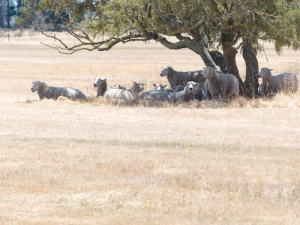Westpac expands community banking with new vans and extended branch hours
Westpac NZ has announced new initiatives that aim to give customers more options to do their banking in person.
 Long time between drinks: Sheep graze dry pasture a few kilometres west of Christchurch Airport in early December, on the day the airport weather station recorded its 46th consecutive day of no rain, bettering a record set in 1954.
Long time between drinks: Sheep graze dry pasture a few kilometres west of Christchurch Airport in early December, on the day the airport weather station recorded its 46th consecutive day of no rain, bettering a record set in 1954.
The threat of a big drought is prompting Westpac to contact its farmer clients to see what help they may need.
Andrew Hill, senior manager of risk and strategy for agribusiness, says the bank is talking to farmers and their families who are under stress, to see what the bank can do now to help them personally, and to buy extra feed if needed.
“We will be… asking what contingency plans they have made,” he told Rural News.
“We are starting to hear about people talking about once-a-day milking and starting to look after their better-performing cows to try to maintain production and make sure cows recently mated don’t lose their calves.”
Hill says farmers early-on have been using surplus cash to repay debt. But he acknowledges that with the likely lower dairy payout less cash will be around and farmers must manage this well.
Meanwhile, Agriculture Minister Damien O’Connor says the ongoing dry is forcing hard decisions on more farmers and horticulturalists. Recent rains were insufficient; MPI is watching this and regularly updating him.
“Government acknowledges we are facing climate change,” he says. “Now all primary sectors must build more resilient systems to deal with the changes in climate that we have experienced in the last few years.”
O’Connor says on his own patch, the West Coast, the lack of rain is challenging farmers.
This is backed up Rebecca Keoghan, who runs Landcorp farms on the West Coast and is a director of Westland Milk Products. She describes the situation as “hideous”.
“People are saying it’s a green drought, but we are actually in the midst of a brown drought now because there is no grass anywhere in the region. What little rain we have had won’t be enough to make a change. I suspect part of our season is lost; I don’t think we’ll recover from it unless we get a decent rain.”
Keoghan says Landcorp has been planning a drought strategy for about 18 months and is well prepared to cope. She says the Coast has gone from the wettest winter in 40 years to the driest summer in 40 years.
Primary sector leaders have welcomed the announcement of a Free Trade Agreement between India and New Zealand.
At Pāmu’s Kepler Farm in Manapouri, mating has wrapped up at the across-breed Beef Progeny Test.
More than 150 people turned up at Parliament recently to celebrate the 20th anniversary of Horticulture New Zealand (HortNZ).
Biosecurity New Zealand says Kiwis should continue to keep an eye out for yellow-legged hornets (Vespa velutina) over the holiday season.
The Push-Up Challenge, an event which combines mental health and fitness, is set to launch in New Zealand in 2026.
Fonterra has slashed another 50c off its milk price forecast as global milk flows shows no sign of easing.

OPINION: The release of the Natural Environment Bill and Planning Bill to replace the Resource Management Act is a red-letter day…
OPINION: Federated Farmers has launched a new campaign, swapping ‘The Twelve Days of Christmas’ for ‘The Twelve Pests of Christmas’ to…